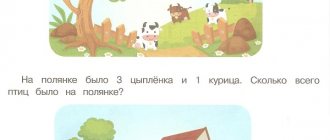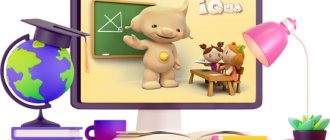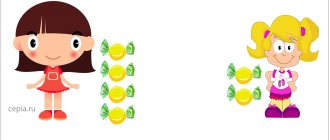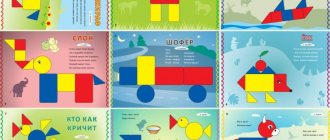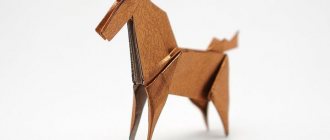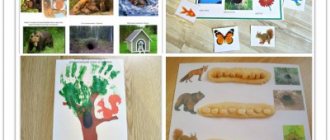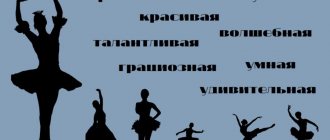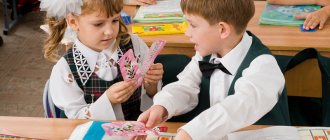Logic puzzles for preschoolers 5-6 years old (for attentiveness, memory development)
10 interesting and exciting tasks for preschoolers. Source: www.liveinternet.ru
Task 1: Katya, Galya and Olya drew heroes from the village of Prostokvashino: Pechkin, Sharik and Matroskin. Who drew who, if Katya didn’t draw Pechkin and Sharik, and Galya didn’t draw Pechkin?
Task 2: There is a maple tree. There are two branches on the maple tree, on each branch there are two cherries. How many cherries are there in total?
Problem 3: If a goose stands on two legs, then it weighs 4 kg. How much will a goose weigh if it stands on one leg?
Problem 4: Two sisters have one brother each. How many children are in the family?
Problem 5: A giraffe, a crocodile and a hippopotamus lived in different houses. The giraffe did not live in a red or blue house. The crocodile did not live in a red or orange house. Guess which houses the animals lived in?
Problem 6: Once upon a time there were three girls: Tanya, Lena and Dasha. Tanya is taller than Lena, Lena is taller than Dasha. Which girl is the tallest and which is the shortest? What is the name of which one?
Problem 7: Misha has three carts of different colors: red, yellow and blue. Misha also has three toys: a tumbler, a pyramid and a spinning top. In the red cart he will not carry a spinning top or a pyramid. The yellow one is not a spinning top or a tumbler. What will Misha carry in each of the carts?
Problem 8: The dragonfly is not sitting on a flower or on a leaf. The grasshopper does not sit on a fungus or on a flower. The ladybug is not sitting on a leaf or on a fungus. Who is sitting on what? (It’s better to draw everything.)
Problem 9: Alyosha, Sasha and Misha live on different floors. Alyosha lives neither on the top floor nor on the bottom. Sasha lives neither on the middle floor nor on the bottom. On what floor does each boy live?
Problem 10: Three plates contain different fruits. The bananas are not in a blue or an orange plate. Oranges are not in a blue or pink plate. What plate are the plums in? What about bananas and oranges?
The need for logic problems for children
Various logic riddles help to activate the thought process, encourage you to think, reason, analyze, and draw your own conclusions. Deciphering each task is an opportunity to develop ingenuity and perseverance.
Unlike mathematical examples, logical problems are not designed to search for quantitative characteristics of an object, but to determine and analyze the relationships between all elements in the task.
Solving logical problems for 6-year-old children leads to concentration on one object for a long time, which is so necessary in the process of learning at school. Exercises develop the ability to remember the proposed material, analyze the situation, promote self-development and are occupational therapy.
Learning to think outside the box is the path to a rational and objective solution to various life problems. This is an opportunity to find a way out of any difficult situation in the future.
Logical problems in mathematics for ingenuity and ingenuity with answers
AWARENESS TASKS
- There were 9 steamships at sea. 2 ships docked at the pier. How many ships are there at sea? (9 ships.)
- There were 7 brothers walking, each brother had one sister. How many people walked? (8 people).
- What kind of dishes can you not eat anything from? (From empty.)
- The animal has 2 right legs, 2 left legs, 2 legs in front, 2 in back. How many legs does an animal have? (4 legs.)
- 9 sharks were swimming in the sea. They saw a school of fish and dived deep. How many sharks swam in the sea? (9 sharks, only they dived.)
- The vase contains 3 tulips and 7 daffodils. How many tulips are there in a vase? (There were 3 tulips in the vase.)
- 7 boys cleared one path in the garden. How many paths did the boys clear? (7 tracks.)
- 2 brothers each drew 2 drawings as a gift to their grandfather. How many drawings did grandfather receive? (4 pictures.)
- The grandmother knitted scarves and mittens for her grandchildren. In total she knitted 3 scarves and 6 mittens. How many grandchildren did your grandmother have? (3 grandchildren - explain the answer.)
- Grandfather, grandmother, granddaughter, Bug, cat and mouse pulled and pulled and finally pulled out the turnip. How many eyes saw the turnip? (12 eyes.)
Children collected an autumn bouquet in the park. It contained 5 maple, 4 birch, 2 oak, 1 aspen leaves. How many different trees did the bouquet come from? (From 4 trees.)
logicheskie_zadachi
What types of tasks do children like?
Preschool children prefer to solve puzzles with a set of colorful pictures, applications, and a well-thought-out motivation system (if they guess correctly, a new chip or word is revealed).
For each age, the tasks are divided according to the degree of difficulty, the presence of color, with one answer or several. Tasks can be of the same type, like a series of complementary puzzles, or contain different logical implications.
Popular options:
- searching for a soul mate;
- establishing correspondence - true or false;
- addition of geometric figures;
- simple algorithms;
- spatial thinking tasks;
- question on logic and ingenuity;
- tasks for weighing and transfusion.
These can also be chess tournaments, non-standard logical tasks and text puzzles.
Examples of problems with answers
Logic problems can be solved on the LogicLike online platform or purchased a printed version. Each riddle is accompanied by an answer, so you can independently check what is said with the existing solution.
Finding an extra item
An entertaining picture game for preschoolers involves choosing an extra object or word.
Problem 1
Drawn: sofa, wardrobe, lamp, table. It is necessary to determine what feature unites the objects and why one of the presented objects is redundant.
Answer: a lamp, because it is used for interior decoration, while other items are classified as furniture.
Similar options:
- wolf, fox, cat, bear;
- summer, morning, winter, spring;
- raspberries, lingonberries, viburnum, plums;
- truck, bike, car, scooter.
Problem 2: “the fourth wheel”.
There are 4 figures depicted: square, triangle, rhombus and circle. You need to choose the extra one.
Answer: circle, because other figures have angles.
Simple logic riddles
There are many options for logic problems for preschool and school age.
Popular:
- There are 5 magpies sitting in the garden bed. Three more flew towards them. The cat crept up and grabbed one magpie. How many birds are left sitting in the garden bed? (Answer: everyone flew away)
- When a heron stands on one leg, it weighs 5 kg. How much will she weigh if she stands on both legs? (Weight will not change)
- There were 5 apples on the table. One was cut into 4 parts. How many apples are left? (5)
- There were 3 glasses on the table. Vanya came up and drank from one. How many glasses are left? (3)
- A hat without a head, and a foot without a boot - what is this? (Mushroom)
- What tree does a hare hide under in the rain? (Under the wet)
- A man walked into the forest, and two acquaintances met him. How many people went into the forest? (One, the others went in the opposite direction)
- Cut the loaf into 3 parts. How many cuts were made? (2)
- If a white handkerchief is lowered into the Red Sea, what will it be like? (Wet)
- Which figure has neither beginning nor end? (Circle, oval)
- The tourist walked towards the lake, reached an intersection where four paths were indicated: right, left, to the lake and back. There were two guys sitting there, one of them always spoke the truth, and the other lied. They answered “yes” or “no” to all questions posed. It was difficult for the tourist to understand who was telling the truth. And then he said something to one of the guys, from whose answer he learned which road leads to the lake. What were those words? (Does this road lead to the lake?)
Such riddles open up an unknown world to the child, train voluntary attention, and develop intelligence. Solving problems like this is fun.
Search for a pattern
Pattern-finding tasks teach students to compare, reason, classify, draw their own conclusions, and fantasize.
Examples of problems in mathematics:
- restore the pattern - 0.10,110....11110 (1110);
- continue the number series: 23, 23, 21, 25, 19, 27 (17 and 29 - 2 less and 2 more).
There may also be tasks with a choice of presented answer options, from which you need to find the correct result.
For example, continue the series of numbers: 29, 28, 26, 23.
Possible answers:
- 20, 17, 14…
- 19, 14, 8…
- 26, 28, 29…
- 16, 10, 4…
It is important to establish compliance with the pattern.
One more task:
| 3 | 12 | 6 |
| 4 | 16 | 8 |
| 5 | 20 |
You need to enter the answer in the field. Result: 10.
Arithmetic puzzles
Numerical, arithmetic, letter, and mathematical puzzles are an entertaining game for children aged 5 years and older. Solving codes contributes to the development of attention, perseverance, and determination in a child. This is the path to gaining new knowledge.
Even simple addition and subtraction problems train logic and develop speed of thinking.
The picture shows: 3 (circle) 1 (square) 2 (circle) 3 = 5. Task: what sign is hidden in the circle? Answer: 3+1-2+3=5
When solving arithmetic puzzles, it is important to be able to draw a thread of logical conclusions and carry out arithmetic operations.
How to build a lesson
In order for a child to learn to reason, make objective decisions, think flexibly and outside the box, it is necessary to create the right conditions for conducting lessons.
It is important not to overload children so that the game does not become a burden. The duration of the lesson is no more than 15-25 minutes with a break of 5 minutes. This time is enough for new knowledge to be consolidated in the child’s mind. Lessons should be taught every day in a playful way. School-age children can perform the given exercises independently.
MAGAZINE Preschooler.RF
"Entertaining tasks for preschoolers"Yazkova Ekaterina Viktorovna GBOU School 2121 preschool building 2
Challenges of ingenuity, puzzles, and entertaining games arouse great interest among the children. Children can, without distraction, practice transforming figures for a long time, rearranging sticks or other objects according to a given pattern, according to their own ideas. In such activities, important qualities of the child’s personality are formed: independence, perseverance is developed, and constructive skills are developed.
Entertaining mathematical material is also considered as one of the means that ensures a rational relationship between the teacher’s work in and outside the classroom. Such material can be included in the main part of the lesson on FEMP or used at the end of it, when there is a decrease in the mental activity of children. Thus, puzzles are useful for consolidating ideas about geometric shapes and their transformation. Riddles and joke problems are appropriate during learning to solve arithmetic problems, operations with numbers, and when forming ideas about time. At the very beginning of classes in the senior and preparatory groups, the use of simple entertaining tasks as “mental gymnastics”
The teacher can also use entertaining mathematical games to organize children’s independent activities.
In the course of solving ingenuity problems and puzzles, children learn to plan their actions, think about them, look for an answer, guess the result, while showing creativity. This kind of work activates the child’s mental activity.
The interest of mathematical material is made by the game elements contained in each problem, logical exercise, entertainment, be it chess or the most elementary puzzle. For example, the unusual way of asking the question: “How can you make a square on a table using two sticks?” - makes the child think and get involved in the game of imagination in search of an answer.
GAME “Chain of Examples”
Goal: To train children in the ability to perform arithmetic operations.
How to play: Two groups of children sit on chairs, one opposite the other. One child takes the ball, calls the example 3+2 and throws the ball to someone from the other group. The one to whom the ball is thrown gives an answer and throws the ball to a player from the first team. The one who caught the ball continues the example, in which he must perform an action with a number, which is the answer in the first example. A participant in the game who gives an incorrect answer or example is eliminated from the game. The group of children with the most players left wins.
GAME “Guess the number”
Goal: To strengthen children's ability to compare numbers.
Progress of the game: According to the leader’s instructions, the child must quickly name the number(s) less than 8 but greater than 6; more than 5 but less than 9, etc. The child who fulfills the conditions of the game receives a flag. When dividing children into 2 groups, the one who answered incorrectly is eliminated from the game.
GAME “How many candies to take”
Goal: To train children in accordance with the conditions of the task and the result.
Progress of the game: The condition of the problem is proposed: “There are 2 types of candy in a paper bag. They take several candies at random. What is the smallest number of candies you need to take so that among them there are at least 2 candies of the same type? (at least 3). The problem is solved through logical thinking.
The problem about apples is solved in the same way: “There were three apples in the vase. Mom treated them to three girls. Each of the girls received an apple, and one remained in the vase. How did it happen?" The problem solver comes to the answer through reflection and correlation of conditions with the result. (One girl took the apple along with the vase.)
Mathematical entertainment is represented by various kinds of tasks, exercises, games on spatial transformations, modeling, recreation of silhouette figures, figurative images from certain parts. They are exciting for children. The solution is carried out through practical actions in compiling, selecting, and arranging according to the rules and conditions. These are games in which you need to create a silhouette figure from a specially selected set of figures, using the entire proposed set of figures. In some games, flat figures are created, in others, three-dimensional ones.
Entertaining mathematical material is very diverse in nature, topic, and method of solution. The simplest tasks, exercises that require resourcefulness, ingenuity, originality of thinking, and the ability to critically evaluate conditions, are an effective means of teaching preschool children in mathematics classes, developing their independent games, and entertainment.
| Next > |

